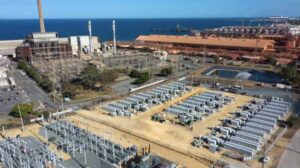The latest power generation costs data from the consultancy Lazard reveals that the coal industry’s preferred climate escape route of promoting carbon capture and storage (CCS) on coal power plants has disappeared as a financially viable option.
For well over two decades the coal mining and power industry has, with ever diminishing enthusiasm, hyped the prospect that carbon capture and storage technology bolted on to coal power plants could overcome growing public concern about damage to the global climate.
In 2017 Lazard estimated (p. 2) that energy from an integrated gasification combined-cycle (IGCC) plant with 90 per carbon capture cost $US231 per megawatt hour (MWh), far more expensive than both solar and wind generation. (In an IGCC plant coal is gasified and then burnt in a gas-fired turbine.) Significantly, Lazard did not include the cost of transport and storage in that cost estimate.
At the time the only IGCC plant with CCS under construction in the US was the almost-commissioned Kemper plant in Mississippi which was designed to run on lignite, the most polluting form of coal. Significantly, the Kemper plant was only designed to capture 65 per cent of the carbon dioxide emissions it generated.
However, in June 2017 the US$7.5 billion Kemper IGCC plant was abandoned and only allowed by the regulator to run on gas from the existing network.
The collapse of the Kemper project, which many pro-CCS advocates had originally touted as an example of the progress of the technology in the power sector, was widely viewed as evidence that, even with generous government financial support, an IGCC plant with CCS was a financial dead-end.
After the Kemper debacle no other utilities have been lining up to pursue the risky technology. Not surprisingly, Lazard’s 2018 analysis of power generation costs excludes any assessment of the costs of IGCC plants at all.
If IGCC with CCS is no longer seen as having any prospect of being viable, what’s left in the world of CCS?
What’s left for CCS?
With Kemper’s CCS plant shelved there remain only two coal-fired power stations with CCS units: the troubled Boundary Dam unit in Saskatchewan in Canada and the Petra Nova plant in Texas.
Both are attached to lignite plants; the Canadian project is nominally designed to capture 90 per cent of the carbon dioxide created. The Petra Nova project is designed to capture about one-third of the carbon dioxide emissions of the 654 MW Unit 8 at the W.A. Parish power station.
Both projects sell the captured carbon dioxide to nearby enhanced oil recovery projects where the CO2 is used to boost production from declining oilfields.
Both project developers boast of the benefits of carbon dioxide captured in terms of the number of cars taken off the road. However, neither account for the emissions from the cars kept on the road from the additional oil production from the use of the compressed CO2injected into the oil field.
With only two commissioned CCS projects in the power sector, supporters of the technology claimed that potentially big cost savings could be achieved in subsequent plants to make CCS a competitive option.
For example, SaskPower, the owner of the Boundary Dam 3 plant in Canada, claimed potential savings of 30 per cent were achievable and aimed to add CCS units to the other two lignite units at the site.
It wasn’t to be. Earlier this year SaskPower ruled out further CCS units at the plant, which may be closed as soon as 2019. SaskPower’s enthusiasm for the technology remains undimmed with the utility claiming that a 50 per cent reduction in costs could be achieved by adding CCS to the larger nearby Shand coal plant.
However, Lazard’s 2018 data offers little encouragement for supporters of the technology.
The consultancy estimates that energy from of an unsubsidised coal plant with a CCS unit capturing 90 per cent of the carbon dioxide would cost $US143 per MWh.
Since 2010, Lazard’s estimates of the cost of energy of such a plant have declined by just 5.9 per cent.
In comparison, over the same period the costs of energy from the most expensive utility-scale solar projects and wind farms have declined by 88 per cent and 62 per cent respectively. In its latest report Lazard found that in the last year the cost of energy from utility-scale solar fell by 13 per cent and energy from onshore wind farms by almost 7 per cent.
While Lazard notes the rate of decline in costs for solar and wind is slowing, the financial reality is that coal plants with CCS have lost the cost race.
According to Lazard’s data, the gaps in the energy cost between coal with a CCS unit and the most expensive US utility-scale solar and wind farms are now $US97 and $US87 per MWh respectively.
Even if the claim that further coal plants with CCS would be 30 or even 50 per cent cheaper came true it would still be insufficient to close the financial lead renewables have built up. This is why most power utilities have given up on the technology and are shifting their focus to renewables, batteries and other technologies.
Even coal mining companies — which are the biggest potential beneficiaries of CCS technology due to increased demand for coal needed to run the energy-hungry CCS unit — won’t put their own money into projects.
Instead, they and their lobby groups want taxpayers to plug the gaping holes in the business case for coal plants with CCS.
Bob Burton is the Editor of CoalWire, a weekly bulletin on global coal industry developments published by CoalSwarm. (You can sign up for it here.) Bob’s Twitter feed is @BobBurtonoz.











